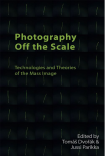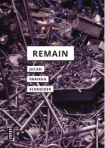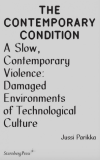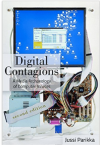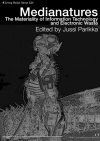Archive
From Turing to Abbey Road, Kentish Radar Stations to Bletchley Park
I am writing a chapter for the Routledge Companion to British Media History. It’s on media archaeology, and I try to offer some insights to how we can decipher British media history through contemporary media arts. This is what I call a minor perspective to media history of Britain – often such a glorified master narrative.
This is just a brief glimpse to the beginning of the chapter. The book should be out in 2014.
Media Archaeology: From Turing to Abbey Road, Kentish Radar Stations to Bletchley Park
British media history has many great stories to tell. It has been one of the biggest inspirations for a range of accounts and for scholars that have tried to decipher the main trends of the media of modernity; from the nineteenth century establishment of standardized mail to the twentieth century Britain of the BBC that, for instance, for this author became a central symbol when he turned on the television in 1980s Finland. BBC content traveled across national boundaries, both in the structural form it provided for public broadcasting as well as through Bergerac and the FA Cup Finals over the years. British exports from television to microcomputing continued, and have established such a status that writing Britain into media history is rather redundant. It is already there, and always was there; even before actual media technologies became subsumed into the consolidated consensus about media as mass media emerged. Indeed, Britain was already there with its investment in transatlantic cables as well as pioneering scientific inquiries, in electricity and electromagnetism, prehistories of computing from Babbage to Turing and so forth. Early on, British media history was already transnational, like the transatlantic cables and telegraph clicks. It is irreducible to a simple national story, and more like something that presents an interesting case for consideration in relation to both the master narratives and the minor themes of media history.
Archival Infusions. An Interview with Robin Boast
Here another earlier recorded interview I did, this time with Dr Robin Boast. Our chat was inspiring for me, as usual; we talked archives, metadata, cultural heritage institutions and digital culture, and I always find Boast’s insights so provocative, so fresh. Boast is really someone who can talk of archival fevers and the history of the discipline; archive as a profession and an institution. He offers wonderful archival, museum science and anthropological  insights, infusions, into digital culture.
insights, infusions, into digital culture.
You can find the interview Mp3 here. The timing of re-uploading of the interview, from January 2011, is good; Boast has just been appointed Professor of Cultural Information Sciences at the University of Amsterdam in Netherlands, leaving behind UK and Cambridge. Great catch for Amsterdam!
Just to remind: all of these interviews I have been posting were made originally in the context of the Creative Technology Review podcasts, that I did with Julio D’Escrivan.
Platform Politics-conference: Opening Words
 We organized a very successful Platform Politics-conference in Cambridge, May 11-13, where our speakers included such exciting scholars and writers as Michel Bauwens, Michael Goddard, Tiziana Terranova, Nick Couldry, Nick Dyer-Witheford, Felix Stalder, and Tim Jordan.
We organized a very successful Platform Politics-conference in Cambridge, May 11-13, where our speakers included such exciting scholars and writers as Michel Bauwens, Michael Goddard, Tiziana Terranova, Nick Couldry, Nick Dyer-Witheford, Felix Stalder, and Tim Jordan.
These are my short opening words to the event:
Platform Politics takes place as part of the Arts and Humanities Research Council founded networking project on Network Politics. We pitched it to the AHRC with the suggestion that it takes one to know one: to understand emerging forms of social action and politics on networks and in network society, one has to develop networks, to crowdsource ideas from leading scholars, activists, artists; to map and to bring through various channels such partipants together in order to identity themes and directions which need more focus. Hence, we have arrived at the third and final event of the project – now on Platform Politics, following the first event in Cambridge on Methodologies of Network Politics research, and last year in Toronto at the Infoscape research lab with help from Greg Elmer, Ganaele Langlois and Alessandra Renzi we discussed object oriented and affect approaches to network politics.
We wanted to keep the notion of platform quite broad in order to solicit a more open range of papers. Hence, from software platforms such as Twitter and Facebook to robotics, from theoretical insights that draw from post-Fordist theories of politics and labour to object oriented philosophy, and much more, we have a privileged position to think through the platform (often seen as technological, as in platform studies) as a platform for our investigations (hence, also as a conceptual affordance). This does not mean to say that platform studies as represented in the Bogost and Montfort led series is techno-determinist, and solely focuses on such – quite the contrary, it tries to find a specific relation between technology and aesthetics. Yet, it is good to emphasize the mobilization of the concept as part of various transitions, and translations: platforms in technological (and again there various levels from apps to clouds, online platforms to technological hardware structures), conceptual, economic and of course political sense (expect at least a couple of references to Lenin in this conference).
So if Bogost and Montfort make sense of platform studies through this kind of layering:
I would add that the notion of platform politics is able to articulate various levels together, and bring smoothness and movement to the interaction of the layers. In other words, in addition to the specific level of “platforms” we can think of the platform itself as distributed on a variety of layers as assemblages (in the manner Manuel Delanda uses the term?). A good example of this – something we were unable to pursue because of the problem of finding the slot for it! – was the idea of organizing a circuit bending/hardware hacking workshop (with Seb Franklin). The idea was to follow Garnet Hertz’s lead, and the way he has organized such workshops both to kids as well as to media theorists — and to use hands-on tinkering, opening up technology such as battery-operated toys, as a way to think through hardware platforms, how design solutions incorporate politics, how they afford conceptual approaches, and act as one node across a variety of other platforms. (An example of such is articulated in the forthcoming “Zombie Media: Circuit Bending Media Archaeology into an Art Method”-text, by myself and Hertz, in Leonardo-journal where we tie the question of such design politics of hardware to media archaeology, art methods and the political economy of network culture).
Platforms reveal to be ontogenetic – i.e. creative forms of interaction, not just stable backgrounds for a continuation of the social. They organize social action in a double bind where social action organizes them. Platforms rearticulate the social. For instance software platforms constitute a catalyzer for specific social forms, and as such incorporate in themselves a multitude of social, political, economic forces. It is a question of production – and of what kinds of social relations are being produced, a good example being the Telecommunist project and the Thimbl open source distributed microblogging service that incorporates a different sociability than proprietorial web 2.0 business and software models. And yet, this sociability is grounded on the level of the potentials of networks, the P2P instead of Web 2.0, distributed instead of the centralized client-server-model.
At the beginning of the project, we started with the question of “”what is network politics?”” and requested initial position papers from some key writers in the field – today of those we have Tiziana Terranova and Greg Elmer attending. Other theorists included Alex Galloway, Eugene Thacker, Katrien Jacobs and Geert Lovink.
The idea was to organize this as a form of request for comments – the RFC format, familiar from internet design culture, of questioning, lining up comments and positions, which however did not pan out as extensively as we wanted (this has to do with other organizationally interesting themes concerning spam management in participatory platforms, and so forth). However, what we got from the position papers were some initial leads. Furthermore, we started with some assumptions where to start tracking network politics:
– politics of new network clusters, services, platforms – Twitter, Facebook, as well as mapping alternative forms of software-based ways of organizing traditional political parties as well as new formations, NGOs, and temporally very different groupings/phenomena – whether the suddenly emerging and as suddenly disappearing “like” protests for instance on Facebook, or the more long-term effects of Wikileaks– leak not only in the meaning of leaking secret information, but leaking across media platforms, and reaching a long term sustainability through “old” media trying to come grips with such online activities.
– biopolitics of network culture, or in other words, the various practices which form internet cultures – hence a step outside of the technological focus, to look at what practices define network politics, and as such the links between work and free time, of play and labour, the circulation of affects, sociability, and so forth. Cognitive capitalism but as much affective capitalism. Yesterday (referring to the pre-conference event with Michel Bauwens and Michael Goddard) we got a bit into talking about investments of affect, desire and such topics.
– we were interested too in the metaquestion: what form would investigating network politics have to take? Outside the normal practice of humanities, writing and meeting up in conferences, what are the specific pedagogic and research tools/platforms that are actively changing the politics of education and research inside/outside academia. What are the research/creation platforms that are able to articulate this, so that we are not only stuck with “master’s tools”?
– And in a way, as a more unspecified but as important was the question of politics of the imperceptible: what kinds of forms of politics there are out there that are not even recognized as politics? From artistic practices to the grey work of engineers, new arenas of expertise, skill and again, social action contribute to the way in which politics is fleeing from traditional institutions.
The project has been able to map various positions to such questions, and raise new ones – which has been the purpose of this all: to produce more leads for further work. The same thing applies to this conference, and we are hoping to come out with excellent contributions, that do not fall within such original ideas. During the project’s unfolding, “network politics” became a wider popular media phenomenon too, where old media started to focus on what is was able to brand as “twitter-revolutions, or facebook-revolutions” – and yet this only emphasized the need to complexify the notions, and the histories of such events and platforms, as has been done on various email lists, and various other debate forums already. I am sure we can continue on that, and produce some really exciting discussions – and as always in our events, we really hope that a lot of the emphasis is on discussions in the sessions, as well as outside them.
Launch events for Insect Media – Berlin and Cambridge
Now that Insect Media is out, I am organizing a couple of events sort of as book launches—with a little help from my friends!
One takes place in Berlin, at the Generalpublic.de cultural venue on Schönhauser Allee 167c ( 10435 Berlin) on March 4, Friday, 7 pm – Shintaro Miyazaki will be interviewing me , and hopefully with drinks and nibbles (there has been talk of some Japanese finger food!). Also the book is on sale there, with a small launch discount.
, and hopefully with drinks and nibbles (there has been talk of some Japanese finger food!). Also the book is on sale there, with a small launch discount.
Even before that, in Cambridge, we are organizing a joint event with Joss Hands whose own book @ is for Activism came out in December as well! This takes place February 22, Tuesday, 5 pm at Anglia Ruskin University at 5 pm. The room will be Helmore 251.
Below, a short blurb about that event which we use to discuss more widely some interesting current and future directions of media studies as well:
‘New Directions in Media Studies: Questioning The Digital Turn’.
In their new books Anglia Ruskin lecturers Joss Hands (@ is for activism) and Jussi Parikka (Insect Media) address some of the pressing new issues in Media Studies emerging from the digital revolution in communication technology. This event will act as a book launch, but also offers the chance to address the relevancy of innovative cross disciplinary themes in contemporary Media Studies.
Both books are characterized by distinct theoretical and political perspectives on issues such as the impact of digital networks on collective action, the ontology of politics, economic production, the ‘post-human’ subject and science-arts interdisciplinarity.
Hands and Parikka will offer short introductions to key themes in their books and welcome questions and discussion over wine and nibbles.
The event is sponsored by CoDE – Cultures of the Digital Economy research institute at Anglia Ruskin, and the campus bookshop John Smith’s is offering both books to be purchased during the event.
>Dave Boothroyd talk on censorship, secrecy and memory in digital culture
>A forthcoming talk in Cambridge hosted by the Department of Humanities and Social Sciences and CoDE-institute, Anglia Ruskin University:
1 Feb, 17.00, Anglia Ruskin University, East Road, room Helmore 251
All welcome!
Dr Dave Boothroyd (University of Kent)
‘Lest we forget’: censorship, secrecy and memory in the age of total recall
Censorship and secrecy are widely regarded as antithetical to the open society and the public sphere. In the digital age the decentered communicative network of the internet facilitates the proliferation of data, data-storage capacity and the generalised intensification of surveillance as well as the apparent weakening of censorious control over information and the security of secrets all kinds. The ‘Wikileaks scenario’ not only exposes the easily ‘switchable’ nature of secrecy/disclosure in the context of digital communications culture, it raises issues pertaining to the technicisation of memory and the memorialisation of events.
In this paper I shall approach the interconnections between censorship, secrecy and memory in relation to contemporary techno-culture with a view to identifying the significance of this nexus for the cultural formation of ethical subjectivity (as Levinas, in particular, writes about this). I am not so much concerned here with normative ethical questions related to the technicisation of the censorship, secrecy and memory ‘nexus’ (interesting, even urgent as these often are) but more with how the ethical Subject is produced in this context.
Bio: Dave Boothroyd Director of Cultural Studies, School of Social Policy Sociology and Social Research, University of Kent. He’s the author of ‘Culture on Drugs: Narco-cultural studies of high modernity’ (Manchester University Press, 2006) and is currently writing a monograph for Edinburgh University Press, ‘Ethical Subjects in Contemporary Culture’. He’s a founding Co-Editor of the on-line journal ‘Culture Machine’.
The Creative Technologies Review-podcasts
One of the highlights of my pre-academia career as a freelance journalist when during a phone interview the interviewee, a female at a telecommunications company marketing department or something of approx. 35 years of age, interrupted me: “Oh I am sorry to interrupt the interview but I just have to say you have an amazing telephone voice.”
I blush, stutter, and for a second wonder if my future career is somewhere where I could put my voice into better use, such as in some of those dubious 0800-numbers that offer services of very wide variety.
Instead, I end up as an academic.
Despite the shortness of the flirtation with the idea of using my voice to make money, I have been drawn into something again where I need to talk – publicly. The shock horror at first, but then realizing its actually enjoyable despite the fact that there is always a tiny region in your brain that is probably trying to say something very inappropriate.
Anyhow, CoDE-institute and me with Julio D’Escrivan (whose original idea this was) present: the Creative Technologies Review-podcasting series that commenced in August 2010.
We label it as
“A podcast on technology and creativity, technology mostly misused, unintentionally artistic technology and music technology with the odd splattering of digital economies” and hope it to be usually a 30 min aberration into the interminglings of technology, net culture, a slight dash of political economy, academic stuff and lots of media arts.
It features interviews of creatives, techs and academics, and aims to throw a spotlight both on the work done at CoDE institute in Cambridge but also more widely (as in globally) on creative technology and arts. I am suspecting it turns out to be quite focused on sound, knowing Julio’s interests and expertise in sound art, sonicity, but it will definitely splash into other fields of expression too and I am sure to throw in a nice dose of media theoretical meditation.
Its hopefully soon available on Itunes, but meanwhile episodes can be downloaded here.
Please get in touch if you have feedback, or suggestions for themes, sites, projects, etc. to be featured!
>New Materialism abstracts
>
David M. Berry: Software Avidities: Latour and the Materialities of Code
The first difficultly in understanding software is located within the notion of software/code itself and its perceived immateriality. Here it is useful to draw an analytical distinction between ‘code’ and ‘software’. Throughout this paper I shall be using code to refer to the textual and social practices of source code writing, testing and distribution. In contrast, I would like to use ‘software’ to include products, such as operating systems, applications or fixed products of code such as Photoshop, Word and Excel and the cultural practices that surround the use of it. This further allows us to think about the hacking as the transformation of software back into code for the purposes of changing its normal execution or subverting its intended (prescribed) functions. However, this difficulty should not mean that we stay at the level of the screen, so-called screen essentialism, nor at the level of information theory, where the analysis focuses on the way information is moved between different points disembedded from its material carrier, nor indeed at the level of a mere literary reading of the textual form of code. Rather code needs to be approached in its multiplicity, that is as a literature, a mechanism, a spatial form (organisation), and as a repository of social norms, values, patterns and processes. In order to focus on the element of materiality I want to use Latour’s notion of the ‘test of strength’ to see how the materiality of code, its obduracy and its concreteness are tested within computer programming contests. To do this I want to look at two case studies: (1) the Underhanded C Contest, which is a contest which asks the programmer to write code that is as readable, clear, innocent and straightforward as possible, and yet it must fail to perform at its apparent function. To be more specific, it should do something subtly evil; and (2) The International Obfuscated C Code Contest, which is a contest to write the most Obscure/Obfuscated C program possible that is as difficult to understand and follow (through the source code) as possible. By following the rules of the contest, and by pitting each program, which must be made available to compile and execute by the judges (as well as the other competitors and the wider public by open sourcing the code), the code is then shown to be material providing it passes these tests of strength.
Rick Dolphijn: The Intense Exterior of Another Geometry
Eleni Ikoniadou: Transversal digitality and the relational dynamics of a new materialism
The relationship between digital technology and matter has preoccupied media and cultural theorists for the last two decades. During the 90s it was articulated through a celebration of the disembodied, immaterial and probabilistic properties of information (cybercultural theory). More recently, it has been asserted through a reliance on sensory perception for the construction of a predominantly observable, otherwise void, digital space (digital philosophy). However, alternative materialist accounts may be able to offer more dynamic ways of understanding the heterogeneity, materiality and novelty of digital culture (Kittler, 1999; Mackenzie, 2002; Fuller, 2005; Munster, 2006). Following on their footsteps, this presentation will aim to rethink the ontological status of the digital as immanent to the flows of a ‘new materialism’. The latter is understood as a transversal process that cuts across seemingly distinguished fields and disciplines, such as the arts and sciences, establishing new connections between them. New materialism, then, becomes a concept and a method proper for investigating digital media and their tendency to bring together different aspects of the world in new ways. The paper discusses how an abstract materialist new media theory can enable transversal relations between science studies, philosophy and media art, as well as between the actual and the virtual dimensions of reality; allowing the emergence of heterogeneous digital assemblages of material, aesthetic and scientific combination.
Adrian Mackenzie: Believing in and desiring data: ‘R’ as the next ‘big thing’
How could materialist analysis come to grips with the seeming immateriality of data network media? This paper attempts to think through some of the many flows of desire and belief concerning data. In the so-called ‘data deluges’ generated by the searches, queries, captures, links and aggregates of network media, key points of friction occur around sharing and pattern perception. I focus on how sharing and pattern perception fare in the case of the scripting language R, an open source statistical ‘data-intensive’ programming language heavily used across the sciences (including social sciences), in public and private settings, from CERN to Wall Street and the Googleplex. R, it is said, is a ‘next big thing’ in the world of analytics and data mining, with thousands of packages and visualizations, hundreds of books and publications (including its own journal, /R Journal/) appearing in the last few years. In this activity, we can discern vectors of belief and desire concerning data. The tools and techniques developed in R can be seen both intensifying data, and at times, making the contingencies of data more palpable.
Stamatia Portanova: The materiality of the abstract (or how movement-objects ‘thrill’ the world)
Anna Powell: Affections in their pure state? The digital event as immersive encounter
Iris Van der Tuin: A Different Starting Point, A Different Metaphysics: Reading Bergson and Barad Diffractively
New Materialisms and Digital Culture -symposium
 Please find below information and registration possibility for our symposium
Please find below information and registration possibility for our symposium
on new materialist cultural analysis as well as info for the launch event of the
CoDE institute and the affiliated Digital Performance Laboratory.
An International Symposium on Contemporary Arts, Media and Cultural Theory
Date: Monday 21 June 2010
Time: 10:00 – 17.30 (18.00 Performance and CoDE Launch)
Venue: Hel 201, Anglia Ruskin University, East Road, Cambridge
Far from being immaterial, digital culture consists of heterogeneous bodies, relations, intensities, movements, and modes of emergence manifested in various contexts of the arts and sciences.
This event suggests “new materialism” as a speculative concept with which to rethink materiality across diverse cultural-theoretical fields of inquiry with a particular reference to digitality in/as culture: art and media studies, social and political theorising, feminist analysis, and science and technology studies.
More specifically, the event maps ways in which the questions of process, positive difference or the new, relation, and the pervasively aesthetic character of our emergences with the world have lately been taken up in cultural theory. It will engage explorations of digital culture within which matter, the body and the social, and the long-standing theoretical dominance of symbolic mediation (or the despotism of the signifier) are currently being radically reconsidered and reconceptualised.
The talks of the event will probe media arts of digital culture, sonic environments, cinematic contexts, wireless communication, philosophy of science and a variety of further topics in order to develop a new vocabulary for understanding digital culture as a material culture.
Speakers include: Dr David M. Berry, Dr Rick Dolphijn, Dr Satinder Gill, Dr Adrian Mackenzie, Dr Stamatia Portanova, Dr Anna Powell, Dr Iris van der Tuin and Dr Eleni Ikoniadou.
The academic programme will be followed by a physical computing and dance performance involving CoDE affiliated staff (Richard Hoadley and Tom Hall) along with choreographers Jane Turner, Cheryl Frances-Hoad and their dancers.
Following the symposium there will also be a short workshop for PhD students on Tuesday 22 June led by Van der Tuin and Dolphijn along with Milla Tiainen and Jussi Parikka. The aim of the workshop is to enable students to discuss and present brief intros to their work on the theme of new materialist analysis of culture and the arts with tutoring from the workshop leaders. The workshop is restricted to max. 10 students. Participation for the selected ten is include in the registration fee. If you are interested, please send an informal message to either milla.tiainen@anglia.ac.uk or Jussi.parikka@anglia.ac.uk along with a short (approx. 1 page) description of your PhD work and its relation to new materialism.
In addition, we are planning an informal introductory workshop for Tuesday afternoon on experimental performance and physical computing.
The event is sponsored by CoDE: the Cultures of the Digital Economy research institute and the Department of English, Communication, Film and Media at Anglia Ruskin University.
Please register your place here
Fee: £20
Programme
Anglia Ruskin University. East Road, Cambridge, UK, Helmore Building, room Hel 201
June 21, Monday
10.00 Welcome and what is new materialism, Milla Tiainen and Jussi Parikka
10.15 Anna Powell (Manchester Met): Electronic Automatism: Video Affects and The Time Image
11.10 Break
11.30 Iris van der Tuin (Utrecht): A Different Starting Point, a Different Metaphysics”: Reading Bergson and Barad Diffractively
Rick Dolphijn (Utrecht): The Intense Exterior of Another Geometry
12.30 Lunch
13.45 Stamatia Portanova (Birkbeck): The materiality of the abstract (or how movement-objects ‘thrill’ the world)
Eleni Ikoniadou: Transversal digitality and the relational dynamics of a new materialism
Satinder Gill (Anglia Ruskin/CoDE and Cambridge University): “Rhythms and sense-making in responsive dense-space’
15.20 break
15.40 David Berry: Software Avidities: Latour and the Materialities of Code.
16.10 Adrian Mackenzie (Lancaster) Believing in and desiring data: R as ‘ next big thing
17.00 closing and a break
18.00 Open launch and drinks event for the Digital Performance laboratory (CoDE, Music and Performing Arts, Anglia Ruskin) and a science-arts interdisciplinary performance Triggered. Recital-hall, Helmore Building (029), East Road, Anglia Ruskin, Cambridge.
‘Triggered’ showcases the results of a practice-as-research project into methods of interdisciplinary collaboration between a group of contemporary dancers, musicians and music technologists. The nature of this collaboration has allowed performance to emerge from artists and disciplines interacting and responding to each other. The bespoke technologies used in the project enable sophisticated dialogue between movement and sound, between music composition and choreography. The nature of interaction and narratives created are key areas of investigation and these areas will explored in a workshop on the second day of the conference. Performing, choreographing, composing and building the production are Cheryl Frances-Hoad, Tom Hall, Richard Hoadley, Jane Turner & dance company.
Day 2 (June 22)
10.00-12.30 Helmore 251
New materialism: art, science, media –workshop with selected PhD students with Dr Iris van der Tuin and Rick Dolphijn, along with Milla Tiainen and Jussi Parikka
12.30-14.00 lunch
14.00 an experimental performance/HCI workshop and interaction possibility with Jane Turner, Cheryl Frances-Hoad, Dr Satinder Gill, Dr Richard Hoadley and Dr Tom Hall.









